七年级英语上册Unit 6教案
- 格式:doc
- 大小:82.00 KB
- 文档页数:4
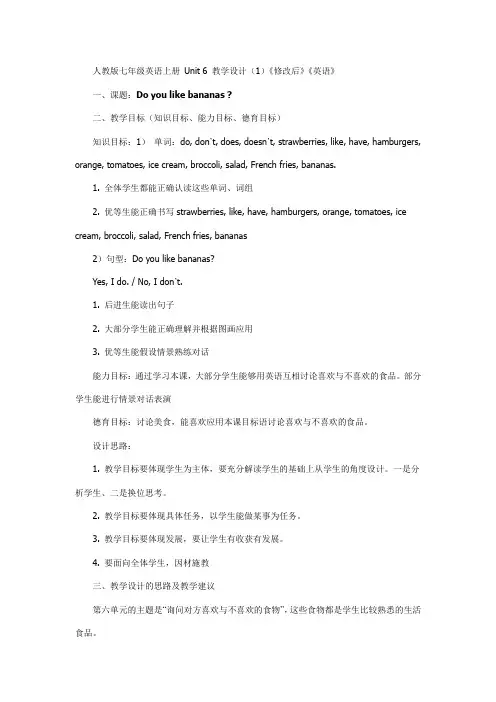
人教版七年级英语上册Unit 6 教学设计(1)《修改后》《英语》一、课题:Do you like bananas ?二、教学目标(知识目标、能力目标、德育目标)知识目标:1)单词:do, don’t, does, doesn’t, strawberries, like, have, hamburgers, orange, tomatoes, ice cream, broccoli, salad, French fries, bananas.1. 全体学生都能正确认读这些单词、词组2. 优等生能正确书写strawberries, like, have, hamburgers, orange, tomatoes, ice cream, broccoli, salad, French fries, bananas2)句型:Do you like bananas?Yes, I do. / No, I don’t.1. 后进生能读出句子2. 大部分学生能正确理解并根据图画应用3. 优等生能假设情景熟练对话能力目标:通过学习本课,大部分学生能够用英语互相讨论喜欢与不喜欢的食品。
部分学生能进行情景对话表演德育目标:讨论美食,能喜欢应用本课目标语讨论喜欢与不喜欢的食品。
设计思路:1. 教学目标要体现学生为主体,要充分解读学生的基础上从学生的角度设计。
一是分析学生、二是换位思考。
2. 教学目标要体现具体任务,以学生能做某事为任务。
3. 教学目标要体现发展,要让学生有收获有发展。
4. 要面向全体学生,因材施教三、教学设计的思路及教学建议第六单元的主题是“询问对方喜欢与不喜欢的食物”,这些食物都是学生比较熟悉的生活食品。
在教学时老师能够使用实物进行教学,增强学生的学习兴趣和学习效果。
在传授新知识时,为了为学生创设真实的,贴近生活的情境,可以设计一些游戏,即根据不同人对食物的不同喜好,自配营养餐和填写购物清单等,这样不但激发了学生学习的热情,也达到了练习重点句型的目的。
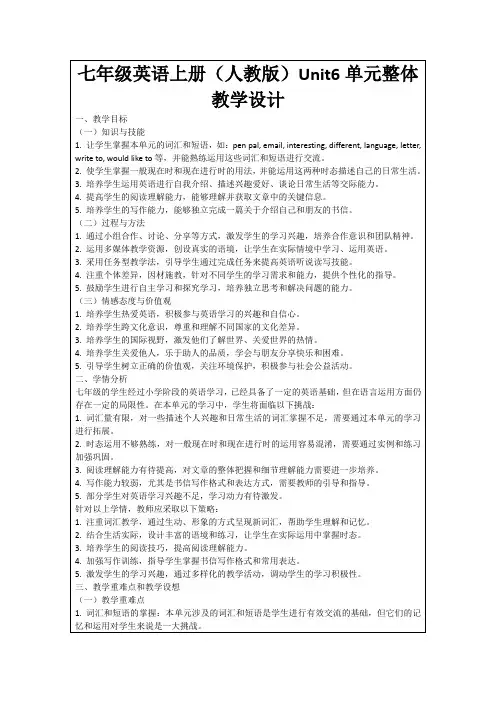
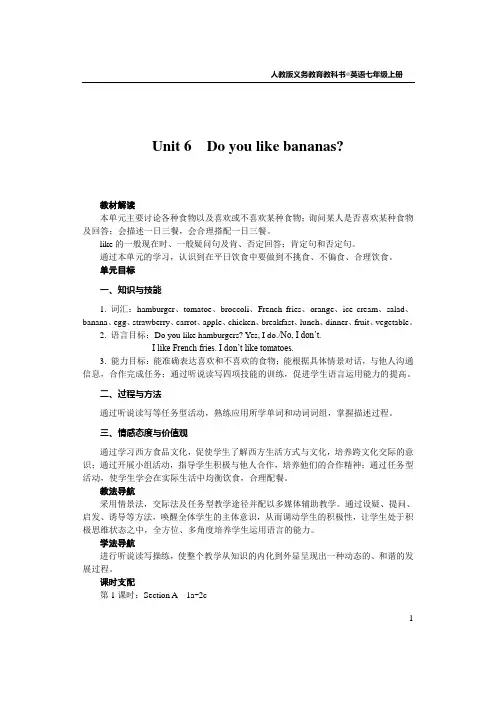
人教版义务教育教科书◎英语七年级上册Unit 6 Do you like bananas?教材解读本单元主要讨论各种食物以及喜欢或不喜欢某种食物;询问某人是否喜欢某种食物及回答;会描述一日三餐,会合理搭配一日三餐。
like的一般现在时、一般疑问句及肯、否定回答;肯定句和否定句。
通过本单元的学习,认识到在平日饮食中要做到不挑食、不偏食、合理饮食。
单元目标一、知识与技能1. 词汇:hamburger、tomatoe、broccoli、French fries、orange、ice cream、salad、banana、egg、strawberry、carrot、apple、chicken、breakfast、lunch、dinner、fruit、vegetable。
2.语言目标:Do you like hamburgers? Yes, I do./No, I don’t.I like French fries. I don’t like tomatoes.3. 能力目标:能准确表达喜欢和不喜欢的食物;能根据具体情景对话,与他人沟通信息,合作完成任务;通过听说读写四项技能的训练,促进学生语言运用能力的提高。
二、过程与方法通过听说读写等任务型活动,熟练应用所学单词和动词词组,掌握描述过程。
三、情感态度与价值观通过学习西方食品文化,促使学生了解西方生活方式与文化,培养跨文化交际的意识;通过开展小组活动,指导学生积极与他人合作,培养他们的合作精神;通过任务型活动,使学生学会在实际生活中均衡饮食,合理配餐。
教法导航采用情景法,交际法及任务型教学途径并配以多媒体辅助教学。
通过设疑、提问、启发、诱导等方法,唤醒全体学生的主体意识,从而调动学生的积极性,让学生处于积极思维状态之中,全方位、多角度培养学生运用语言的能力。
学法导航进行听说读写操练,使整个教学从知识的内化到外显呈现出一种动态的、和谐的发展过程。
课时支配第1课时:Section A 1a-2c1第2课时:Section A 3a-3c第3课时:Section B 1a-2c第4课时:Section B 3a-Self Check课时教案第1课时Section A1a-2c教学目标一、知识与技能1. 掌握基本词汇:food、banana、hamburger、tomato、broccoli、French fries、strawberry、orange、ice cream、salad。
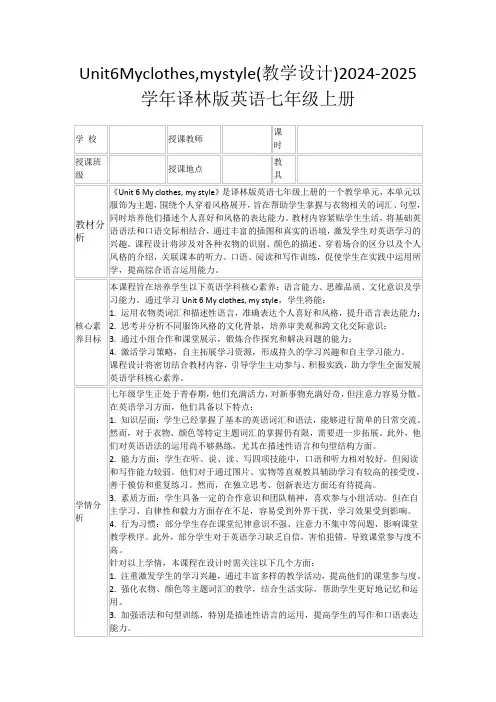
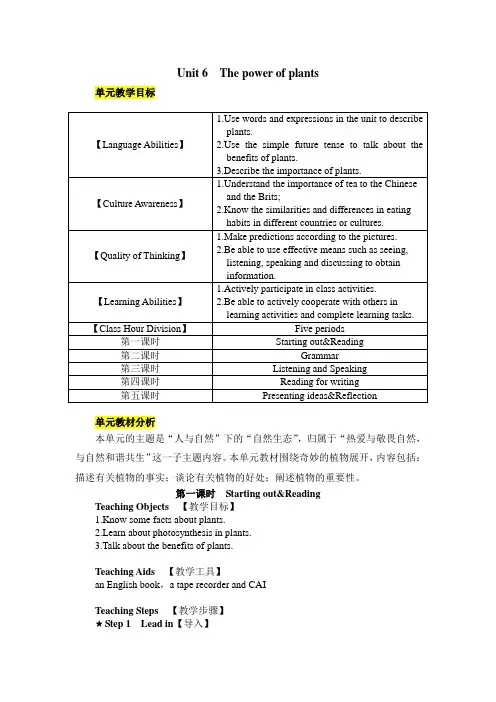
Unit 6 The power of plants单元教学目标单元教材分析本单元的主题是“人与自然”下的“自然生态”,归属于“热爱与敬畏自然,与自然和谐共生”这一子主题内容。
本单元教材围绕奇妙的植物展开,内容包括:描述有关植物的事实;谈论有关植物的好处;阐述植物的重要性。
第一课时Starting out&ReadingTeaching Objects【教学目标】1.Know some facts about plants.2.Learn about photosynthesis in plants.3.Talk about the benefits of plants.Teaching Aids【教学工具】an English book,a tape recorder and CAITeaching Steps【教学步骤】★Step 1Lead in【导入】Show some pictures about different plants to the Ss, such as bamboos, trees and flowers, and then ask them to say the facts about these plants.Starting outPage 95,11.Ask the Ss to look at the picture on page 95 and answer the following question.Do you think plants are amazing? Why or why not?2.Give the Ss some prompts.3.Let some Ss say their answers.Page 95,21.Ask the Ss to look at the pictures and answer the questions.(1)What are the people doing?(2)What can plants do for us?2.Let some Ss say their answers.3.Check the answers with the class.Understanding ideas(1—4)★Step 2 Pre-task【准备任务】1.Show the picture of a plant on page 96 to the Ss, and then ask them to guess what may be filled in the blanks.★Step 3 While-task【过程任务】Page 97,21.Ask the Ss to read the passage on page 97 and fill in the blanks on page 96.2.Ask some Ss to say their answers.3.Check the answers with the class.Page 98,31.Show the four titles to the Ss, and make sure they understand the meanings.2.Ask the Ss to choose another suitable title and give their reasons.3.Let some students say their answers.4.Check the answer with the class.Page 98,41.Show the texts on page 98 to the Ss, and then ask them to guess what may be filled in the blanks.2.Let the Ss complete the texts with the words and expressions from the passage.3.Ask some Ss to say their answers.4.Check the answers with the class.★Step 4Post-task【后续任务】Page 98, Think and share1.Ask the Ss to read the passage and answer the following questions.(1)What does “plant” mean in the title?(2)In what other ways do plants help the world?2.Give the Ss some prompts.3.Let some Ss say their answers.4.Check the answers with the class.★Step 5Language points【语言要点】1.send 的用法作动词,意为“寄,发送;传达;派遣”。
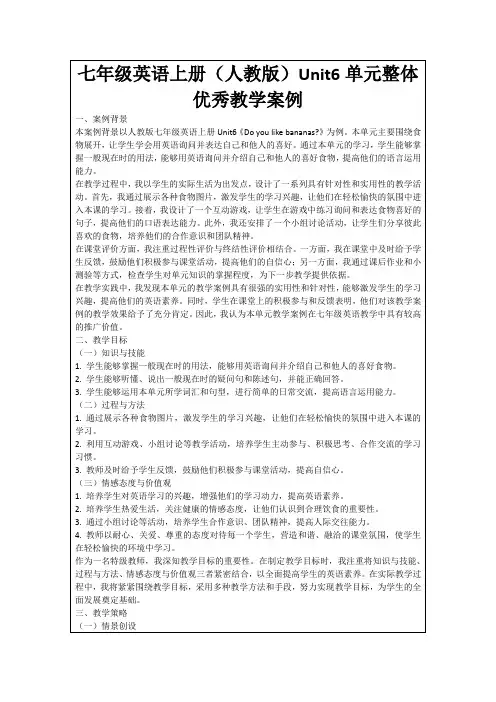
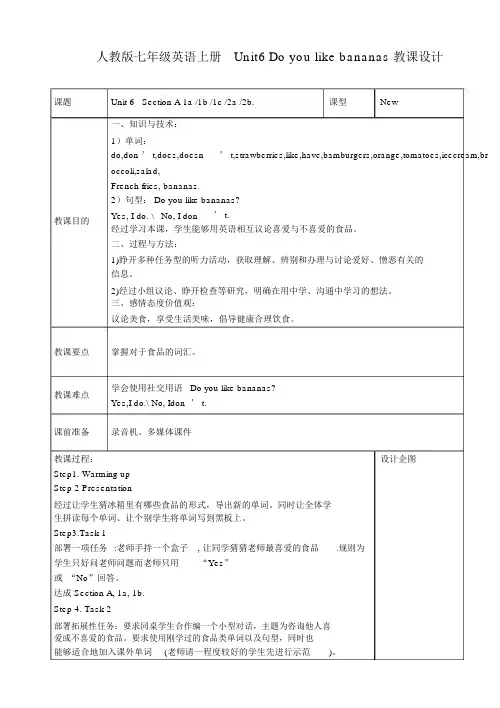
人教版七年级英语上册Unit6 Do you like bananas教课设计课题Unit 6 Section A 1a /1b /1c /2a /2b.课型New一、知识与技术:1)单词:do,don ’ t,does,doesn’ t,strawberries,like,have,bamburgers,orange,tomatoes,icecream,broccoli,salad,French fries, bananas.2)句型: Do you like bananas?教课目的Yes, I do. \ No, I don’ t.经过学习本课,学生能够用英语相互议论喜爱与不喜爱的食品。
二、过程与方法:1)睁开多种任务型的听力活动,获取理解、辨别和办理与讨论爱好、憎恶有关的信息。
2)经过小组议论、睁开检查等研究,明确在用中学、沟通中学习的想法。
三、感情态度价值观:议论美食,享受生活美味,倡导健康合理饮食。
教课要点掌握对于食品的词汇。
教课难点学会使用社交用语 Do you like bananas? Yes,I do.\ No, Idon ’ t.课前准备录音机、多媒体课件教课过程:设计企图Step1. Warming upStep 2 Presentation经过让学生猜冰箱里有哪些食品的形式,导出新的单词。
同时让全体学生拼读每个单词、让个别学生将单词写到黑板上。
Step3.Task 1部署一项任务:老师手持一个盒子, 让同学猜猜老师最喜爱的食品.规则为学生只好问老师问题而老师只用“Yes”或“No”回答。
达成 Section A, 1a, 1b.Step 4. Task 2部署拓展性任务:要求同桌学生合作编一个小型对话,主题为咨询他人喜爱或不喜爱的食品。
要求使用刚学过的食品类单词以及句型,同时也能够适合地加入课外单词(老师请一程度较好的学生先进行示范)。
Step 5.达成课文32 页 Section A 听力练习activity 2a, 2b.Setp 6.当堂听写听写单词与句型,进一步稳固本课学习内容,并将本课应掌握的单词和句型落实到“写”上,使学生不只会说同时会写。
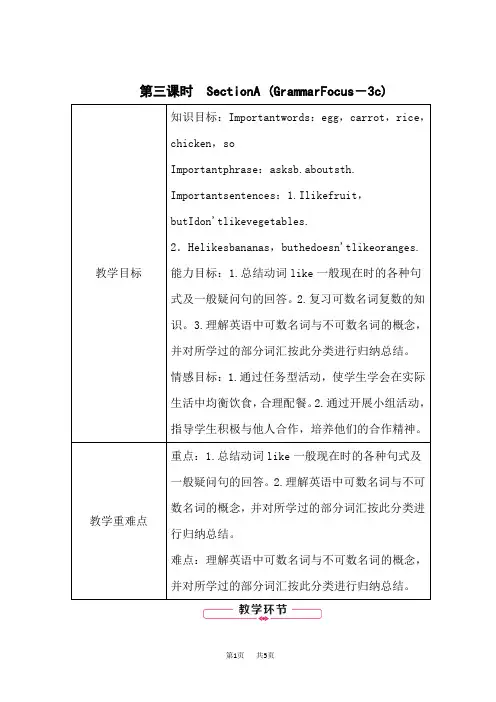
第三课时SectionA (GrammarFocus-3c)Step1 情景导入【参考案例】T:Doyouliketomatoes/oranges/salad…?S1:Yes,Ido./No,Idon't,butIlike…T:Doesshe/heliketomatoes/oranges/salad…?S2:Yes,she/hedoes./No,she/hedoesn't,butshe/helikes…设计意图:通过师生互动问答复习上节课内容,在问答中提醒学生注意一般现在时态第三人称单数的使用。
Step2 畅通GrammarFocus回顾语法重点【操作案例】1.学生阅读GrammarFocus中的句子,总结含有实义动词的一般现在时的句型规律。
2.阅读方框中可数名词和不可数名词,并对所学过的部分词汇按此分类进行归纳总结。
设计意图:学生通过阅读感知句型规律,并做出总结。
通过阅读方框中可数名词和不可数名词,进一步加深理解。
Step3 完成教材3a-3c的任务【操作案例】1.认真阅读3a的5个句子,并在括号内正确的单词下面画线,使句子正确完整。
2.学生说出答案,老师核对,然后让学生大声朗读这些句子,并背诵。
3.认真阅读3b的几个句子,将其编号,组成对话,然后读背。
4.做食物调查。
用“Doyoulike…?”句型就3c表格中的食物向小组成员提问。
找出他们喜欢和不喜欢的食物,并把结果登记在表格中。
设计意图:学生通过参加活动和练习,更好地掌握本课知识。
知识▲可数名词与不可数名词的含义与特点Step4 随堂练习 根据图示,完成句子。
1.Paullikestomatoesand__icecream __.2.Pauldoesn'tlikehamburgersor__strawberries__. 3.Emmalikes__hamburgers__andstrawberries. 4.Emma__doesn't__like__tomatoes__or__icecream. 5.Paullikestomatoes ,butEmma__doesn't__like__them. Step5 板书设计SectionA (GrammarFocus -3c)Importantwords :egg ,carrot ,rice ,chicken ,so Importantphrase :asksb.aboutsth. Importantsentences :1.Ilikefruit ,butIdon'tlikevegetables. 2.Helikesbananas ,buthedoesn'tlikeoranges.Step6 完成学生用书。
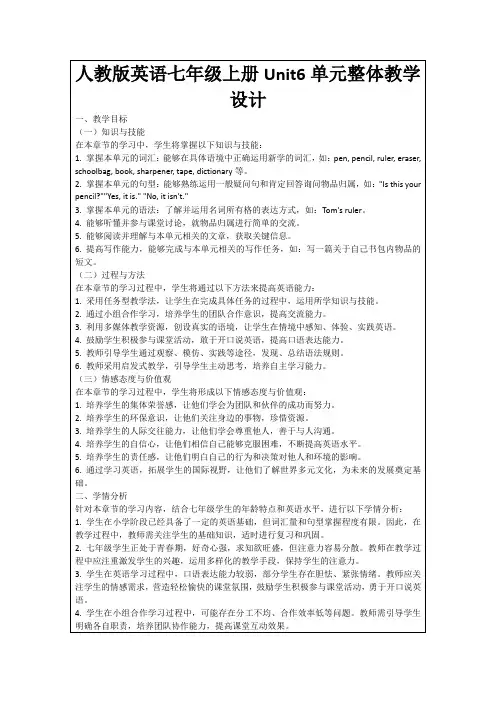
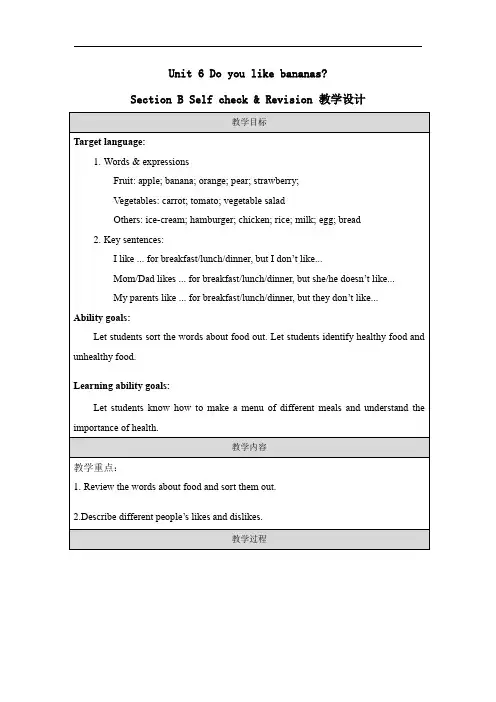
Unit 6 Do you like bananas? Section B Self check & Revision 教学设计Step 1: Warm-upThis week, there will be a Family Day and you need to make a menu of your family’s three meals. What should you do first? Go to find the food in your fridge. Let’s see.Step 2: Revision of vocabulary1.In the fridge, first you can find some fruit. So what fruit can you find? This is astrawberry. This is an apple. This a pear. This is a banana. And this is an orange.2. Then we can find some vegetables. Let’s see what are they? First, this a tomatoand this is a carrot. How about this? It’s vegetable salad.3. Except fruit and vegetables, you can find some other food. For example, there issome ice-cream, a hamburger, chicken, rice, milk, bread and an egg.4. You can see so many kinds of food in the fridge, so if you want to make the menufor your family’s 3 meals, what is very important? Health. Are the foods in the fridge healthy? Put H next to healthy food and U next to unhealthy food.5. So if you want to be healthy, what should we do?You must eat well. It meansyou eat healthy food. And then you have good eating habits.Step 3: Rules of plurals.We’ve learned so many words about food. Some are countable while some are uncountable. For countable nouns, the plural form is also important.1.Self-check 1: Write the plurals of the words in the correct column>2.3.Can you think about more examples about the last 2 groups?+es: potatoes, boxes, watches; y→i+es: libraries4.Now let’s see the rules of plurals.Step 4: Talking about likes and dislikes1.After choosing the healthy food, you need to choose what you and your parents like. We can’t make a menu with food that people dislike.2.Self check 2: Choose the food you like for three meals. Write down 3 sentences.E.g. I like ... for breakfast, but I don’t like...I like ... for lunch, but I don’t like ...I like ... for dinner, but I don’t like.3.Self check 3: How about your parents? Write down 5 sentences about your parents’ likes and dislikes. You can use the following sentence patterns.E.g. Mom/Dad likes... for breakfast/lunch/dinner, but he/she doesn’t like...My parents like ... for breakfast/lunch/dinner, but they don’t like...Homework1.Finish the exercises.2.Make a menu for your Family Day.。
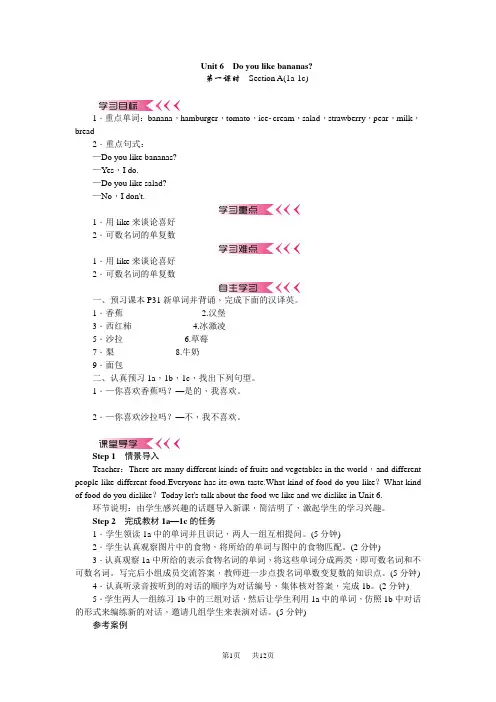
Unit 6Do you like bananas?第一课时Section A(1a-1c)1.重点单词:banana,hamburger,tomato,icecream,salad,strawberry,pear,milk,bread2.重点句式:—Do you like bananas?—Yes,I do.—Do you like salad?—No,I don't.1.用like来谈论喜好2.可数名词的单复数1.用like来谈论喜好2.可数名词的单复数一、预习课本P31新单词并背诵,完成下面的汉译英。
1.香蕉____________ 2.汉堡____________3.西红柿____________ 4.冰激凌__________5.沙拉____________ 6.草莓____________7.梨____________ 8.牛奶____________9.面包____________二、认真预习1a,1b,1c,找出下列句型。
1.—你喜欢香蕉吗?—是的,我喜欢。
________________________________________________________________________ 2.—你喜欢沙拉吗?—不,我不喜欢。
________________________________________________________________________Step 1情景导入Teacher:There are many different kinds of fruits and vegetables in the world,and different people like different food.Everyone has its own taste.What kind of food do you like?What kind of food do you dislike?Today let's talk about the food we like and we dislike in Unit 6.环节说明:由学生感兴趣的话题导入新课,简洁明了,激起学生的学习兴趣。
Unit 6 Section A (1a-1c) 教案1.语言知识目标:1.学习掌握词汇:banana,hamburger,tomato,ice-cream,salad,strawberry,pear,milk,bread2.掌握重点句型Do you like bananas? Yes, I do./No, I don’t.二、能力目标:使学生能够正确运用Do you like.以及回答,谈论对食物的喜好。
三、情感目标:使学生了解同学的喜好,增进友情;了解健康的食物。
教学重难点:1. 教学重点:运用所学词汇进行对话交际练习Do you like...?2. 教学难点:掌握本节课中食物名称以及名词复数的变化。
(Teaching Procedures):Step1:Greetings and talking1.教师向学生表示友好的问候,并复习之前所学到的问候语。
2.采用多种自由交际方式,创设浓厚的英语学习氛围与学生进行Step2: Review展示图片让学生做“Best Eye”来复习球类单词。
Step3: Lead inLet the students enjoy a view “Do you like bananas?” and answer questions to lead in the new lesson.Step4:Presentation1.Learn the new words:Show some pictures to learn new words of fruits and foods.2.Finish 1aLet students match the words with the things in the picture.3.Learn important sentences:展示图片进行师生互动操练重点句型:A: Do you / they like ... ?B: Yes, I/We/They do.No, I/We/They don’t.A: Does he/ she like ... ?B: Yes, he/she does.No, he/ she doesn’t.4.Pair work让学生两人一组操练重点句型:A: Do you / they like ... ?B: Yes, I/We/They do.No, I/We/They don’t.A: Does he/ she like ... ?B: Yes, he/she does.No, he/ she doesn’t.5.Finish 1bListen and number the conversations[1-3].6.Grammar:可数名词单复数变化方法讲解以及不可数名词的用法讲解7.Summary:教师带领学生回顾本节课所上的生词,句型和语法。